Our Stories
BASF plants a promise in East Newark
How a formal industrial site blossomed into a vibrant community park
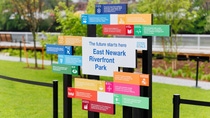
For years, the banks of the Passaic River in East Newark, New Jersey stood quiet, defined more by its industrial past than its potential. Today, that same stretch of land tells a different story—one of renewal, community and sustainability.
This transformation was made possible through a powerful partnership between BASF, the Borough of East Newark and several public agencies. Together, they reimagined five acres of post-industrial vacant land into something greener, cleaner and deeply rooted in community.
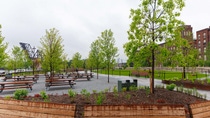
A green space grows
On May 9, 2025, the East Newark community and BASF celebrated the opening of the East Newark Riverfront Park. Designed with sustainability and accessibility in mind, the park features a 1,000 ft boardwalk overlooking the river, a wide lawn perfect for community events, and a playground and open areas for learning and leisure. It’s more than a park—it’s a symbol of what’s possible when innovation meets investment in community.
The park’s design reflects a focus on sustainability. Smart stormwater systems help manage more than 6 million gallons of runoff each year, protecting nearby neighborhoods from flooding and easing pressure on local infrastructure. Materials used throughout the park were carefully chosen—like Trex® Decking made from up to 95% recycled plastic and wood, playground equipment built from responsibly sourced wood, and safety surfacing made from recycled tires. What was once overlooked is now a space that brings people together while helping the planet—it’s a win for both.
With this park, we can say New Jersey is once again leading the nation in protecting our natural wonders while also at the same time creating new opportunities for our neighbors to come together. This park will reconnect this community with the beautiful waterfront for the first time in over a century. As our state’s newest restoration park, the East Newark riverfront park will also serve as a living, breathing environmental asset that will directly support the growth and wellbeing of native plants, pollinators, birds and much more.
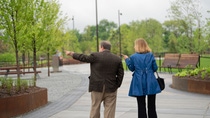
Commitment in action
The project aligns with BASF’s broader commitment to sustainability, not just in chemistry, but in community development. Revitalizing the land also meant restoring the surrounding ecosystem. Native plants and intentional landscaping make the space resilient while contributing to local biodiversity.
The collaboration also sets a precedent for faster, more effective environmental restoration. Working proactively with local and federal partners, BASF helped accelerate a process that often takes decades, bringing tangible benefits to residents now—not later.
This effort reflects BASF’s commitment to creating sustainable solutions that serve both people and the planet. By restoring the site in a way that promotes long-term environmental health, the project supports nearly all of the United Nations Sustainable Development Goals, including those focused on sustainable cities and communities, climate action and life on land.
The park was first envisioned and brought to life by a very talented and passionate team of environmental professionals at BASF, who saw an opportunity to make a difference in their community through environmental justice. Their vision brought this space to life, utilizing a nature-positive design as a blueprint to build a collaboration with the Borough of East Newark and federal partners. BASF remains committed to advancing this important natural resource restoration work in the pursuit of environmental justice, which supports our company’s wider vision of creating chemistry for a sustainable future.
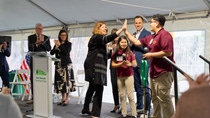
Uniting for greater impact
During every phase of the East Newark Riverfront Park project, BASF focused on creating a space that truly served the local community. To better understand the park’s impact, BASF partnered with Rutgers University’s Experiential Learning Hub, where students explored how the park could provide value beyond restoration, such as improved air quality, mental health and even business for local business owners. Their research helped highlight how green spaces bring both environmental and social benefits to neighborhoods.
Education was another key focus. In partnership with New Jersey Audubon, BASF supported more than 25 hands-on environmental classes for students at East Newark Public School. These after-school programs gave kids a chance to connect with nature and learn about the world around them in meaningful ways.
I would like to recognize BASF for going above and beyond with the park. They provided additional support to our community, our senior center, our youth centers, and they hosted a nature day which was open to our neighboring communities. So thank you BASF.
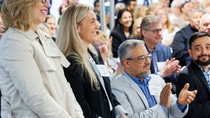
More than just a park
While this new green space showcases an environmental triumph, it signifies something far greater. As the only waterfront park in East Newark, it serves as a green beacon of renewal, proving that progress and preservation can go hand in hand. East Newark gains more than a green space. It gains a gathering space, a breathing space, and a renewed connection to the water that shaped its past and now its future.
This space represents more than a patch of green, it’s a story of transformation. What once stood as a vacant lot now serves as a living example of how thoughtful remediation and design can breathe new life into a community. Every step of the project was guided by a vision to create something lasting, not just safe, clean land, but a place that invites reflection and growth.
I want to give BASF a big round of applause for this work. To say ‘we are going to do the right thing for this community’, we don’t always see that. So thank you BASF, and all the partners who made this a possibility.
Beyond its playgrounds and pathways, the park represents what is possible when environmental restoration meets community investment. It’s a place rooted in science and shaped by purpose, proving sustainability is a blueprint for building stronger, heathier futures. This project shows how remediation can do more than correct the past; it can lay the foundation for something greater.
Written by Olivia Jakubowski.
For media inquiries or to repurpose this article, please contact Lisa Brown.